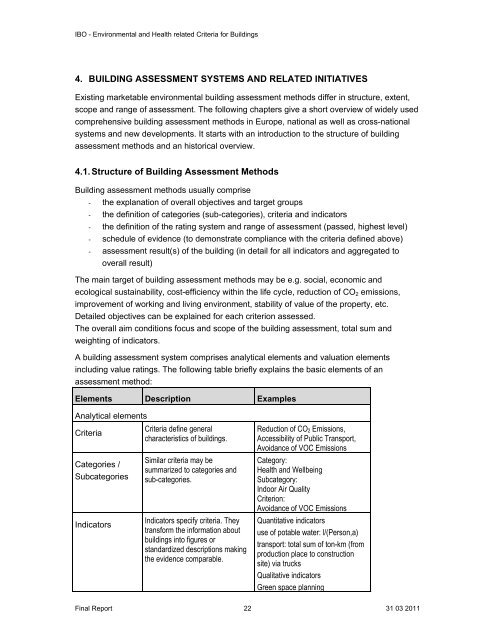Environmental and health related criteria for buildings - ANEC
Environmental and health related criteria for buildings - ANEC
Environmental and health related criteria for buildings - ANEC
Create successful ePaper yourself
Turn your PDF publications into a flip-book with our unique Google optimized e-Paper software.
IBO - <strong>Environmental</strong> <strong>and</strong> Health <strong>related</strong> Criteria <strong>for</strong> Buildings<br />
4. BUILDING ASSESSMENT SYSTEMS AND RELATED INITIATIVES<br />
Existing marketable environmental building assessment methods differ in structure, extent,<br />
scope <strong>and</strong> range of assessment. The following chapters give a short overview of widely used<br />
comprehensive building assessment methods in Europe, national as well as cross-national<br />
systems <strong>and</strong> new developments. It starts with an introduction to the structure of building<br />
assessment methods <strong>and</strong> an historical overview.<br />
4.1. Structure of Building Assessment Methods<br />
Building assessment methods usually comprise<br />
- the explanation of overall objectives <strong>and</strong> target groups<br />
- the definition of categories (sub-categories), <strong>criteria</strong> <strong>and</strong> indicators<br />
- the definition of the rating system <strong>and</strong> range of assessment (passed, highest level)<br />
- schedule of evidence (to demonstrate compliance with the <strong>criteria</strong> defined above)<br />
- assessment result(s) of the building (in detail <strong>for</strong> all indicators <strong>and</strong> aggregated to<br />
overall result)<br />
The main target of building assessment methods may be e.g. social, economic <strong>and</strong><br />
ecological sustainability, cost-efficiency within the life cycle, reduction of CO 2 emissions,<br />
improvement of working <strong>and</strong> living environment, stability of value of the property, etc.<br />
Detailed objectives can be explained <strong>for</strong> each criterion assessed.<br />
The overall aim conditions focus <strong>and</strong> scope of the building assessment, total sum <strong>and</strong><br />
weighting of indicators.<br />
A building assessment system comprises analytical elements <strong>and</strong> valuation elements<br />
including value ratings. The following table briefly explains the basic elements of an<br />
assessment method:<br />
Elements Description Examples<br />
Analytical elements<br />
Criteria<br />
Categories /<br />
Subcategories<br />
Indicators<br />
Criteria define general<br />
characteristics of <strong>buildings</strong>.<br />
Similar <strong>criteria</strong> may be<br />
summarized to categories <strong>and</strong><br />
sub-categories.<br />
Indicators specify <strong>criteria</strong>. They<br />
trans<strong>for</strong>m the in<strong>for</strong>mation about<br />
<strong>buildings</strong> into figures or<br />
st<strong>and</strong>ardized descriptions making<br />
the evidence comparable.<br />
Reduction of CO 2 Emissions,<br />
Accessibility of Public Transport,<br />
Avoidance of VOC Emissions<br />
Category:<br />
Health <strong>and</strong> Wellbeing<br />
Subcategory:<br />
Indoor Air Quality<br />
Criterion:<br />
Avoidance of VOC Emissions<br />
Quantitative indicators<br />
use of potable water: l/(Person,a)<br />
transport: total sum of ton-km (from<br />
production place to construction<br />
site) via trucks<br />
Qualitative indicators<br />
Green space planning<br />
Final Report 22 31 03 2011
















